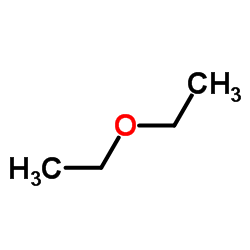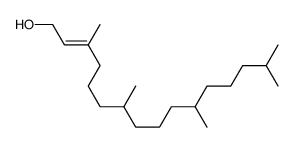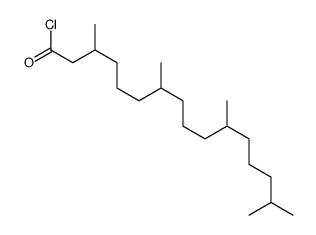Phytanic acid

Phytanic acid structure
|
Common Name | Phytanic acid | ||
|---|---|---|---|---|
| CAS Number | 14721-66-5 | Molecular Weight | 312.530 | |
| Density | 0.9±0.1 g/cm3 | Boiling Point | 422.3±13.0 °C at 760 mmHg | |
| Molecular Formula | C20H40O2 | Melting Point | -65°C | |
| MSDS | Chinese USA | Flash Point | 179.7±11.2 °C | |
| Symbol |

GHS07 |
Signal Word | Warning | |
Use of Phytanic acidPhytanic acid is an endogenous metabolite present in Blood that can be used for the research of Zellweger Syndrome, Alpha Methylacyl CoA Racemase Deficiency, Rhizomelic Chondrodysplasia Punctata and Infantile Refsum Disease[1][2][3][4][5]. |
| Name | phytanic acid |
|---|---|
| Synonym | More Synonyms |
| Description | Phytanic acid is an endogenous metabolite present in Blood that can be used for the research of Zellweger Syndrome, Alpha Methylacyl CoA Racemase Deficiency, Rhizomelic Chondrodysplasia Punctata and Infantile Refsum Disease[1][2][3][4][5]. |
|---|---|
| Related Catalog | |
| Target |
Human Endogenous Metabolite |
| In Vitro | Endogenous metabolites is defined as those that are annotated by Kyoto Encyclopedia of Genes and Genomes as substrates or products of the ~1900 metabolic enzymes encoded in our genome. It is clear in the body of literature that there are documented toxic properties for many of these metabolites[1]. |
| References |
| Density | 0.9±0.1 g/cm3 |
|---|---|
| Boiling Point | 422.3±13.0 °C at 760 mmHg |
| Melting Point | -65°C |
| Molecular Formula | C20H40O2 |
| Molecular Weight | 312.530 |
| Flash Point | 179.7±11.2 °C |
| Exact Mass | 312.302826 |
| PSA | 37.30000 |
| LogP | 8.54 |
| Vapour Pressure | 0.0±2.1 mmHg at 25°C |
| Index of Refraction | 1.454 |
| Storage condition | 2-8°C |
| Symbol |

GHS07 |
|---|---|
| Signal Word | Warning |
| Hazard Statements | H315-H319-H335 |
| Precautionary Statements | P261-P305 + P351 + P338 |
| Personal Protective Equipment | Eyeshields;full-face respirator (US);Gloves;multi-purpose combination respirator cartridge (US);type ABEK (EN14387) respirator filter |
| Hazard Codes | Xi: Irritant; |
| Risk Phrases | R36/37/38 |
| Safety Phrases | 26-36 |
| RIDADR | NONH for all modes of transport |
| WGK Germany | 3 |
| HS Code | 2915900090 |
|
~71% 
Phytanic acid CAS#:14721-66-5 |
| Literature: Hirai, Kunihiro; Katayama, Satoshi; Torii, Takayoshi; Nakaya, Ryotaro; Takahashi, Daisuke Patent: US2013/267697 A1, 2013 ; Location in patent: Page/Page column ; |
|
~% 
Phytanic acid CAS#:14721-66-5 |
| Literature: Karrer; Epprecht; Koenig Helvetica Chimica Acta, vol. 23, p. 280 |
|
~% 
Phytanic acid CAS#:14721-66-5 |
| Literature: Kvita,V.; Weichet,J. Collection of Czechoslovak Chemical Communications, 1960 , vol. 25, p. 254 - 257 |
|
~% 
Phytanic acid CAS#:14721-66-5 |
| Literature: Kvita,V.; Weichet,J. Collection of Czechoslovak Chemical Communications, 1960 , vol. 25, p. 254 - 257 |
|
~% 
Phytanic acid CAS#:14721-66-5 |
| Literature: Karrer; Epprecht; Koenig Helvetica Chimica Acta, vol. 23, p. 280 |
|
~% 
Phytanic acid CAS#:14721-66-5 |
| Literature: Willstaetter; Mayer; Hueni Justus Liebigs Annalen der Chemie, 1911 , vol. 378, p. 114 |
| HS Code | 2915900090 |
|---|---|
| Summary | 2915900090 other saturated acyclic monocarboxylic acids and their anhydrides, halides, peroxides and peroxyacids; their halogenated, sulphonated, nitrated or nitrosated derivatives VAT:17.0% Tax rebate rate:9.0% Supervision conditions:AB(certificate of inspection for goods inward,certificate of inspection for goods outward) MFN tariff:5.5% General tariff:30.0% |
|
Phytanic acid and very long chain fatty acids in genetic peroxisomal disorders.
J. Clin. Chem. Clin. Biochem. 27(5) , 309-14, (1989) 1. Phytanic acid, phytanyl-triacylglycerols, and very long chain fatty acids were analysed by gas chromatography or thin-layer chromatography in blood and tissues of patients with different genetic pe... |
|
|
Polyunsaturated Branched-Chain Fatty Acid Geranylgeranoic Acid Induces Unfolded Protein Response in Human Hepatoma Cells.
PLoS ONE 10 , e0132761, (2015) The acyclic diterpenoid acid geranylgeranoic acid (GGA) has been reported to induce autophagic cell death in several human hepatoma-derived cell lines; however, the molecular mechanism for this remain... |
|
|
New insights into the peroxisomal protein inventory: Acyl-CoA oxidases and -dehydrogenases are an ancient feature of peroxisomes.
Biochim. Biophys. Acta 1853(1) , 111-25, (2014) Peroxisomes are ubiquitous organelles which participate in a variety of essential biochemical pathways. An intimate interrelationship between peroxisomes and mitochondria is emerging in mammals, where... |
| 3,7,11,15-Tetramethylhexadecanoic acid |
| (7R,11R)-3,7,11,15-Tetramethylhexadecanoic acid |
| Hexadecanoic acid, 3,7,11,15-tetramethyl-, (7R,11R)- |
| Phytanic acid |






 CAS#:32607-05-9
CAS#:32607-05-9 CAS#:1189-37-3
CAS#:1189-37-3